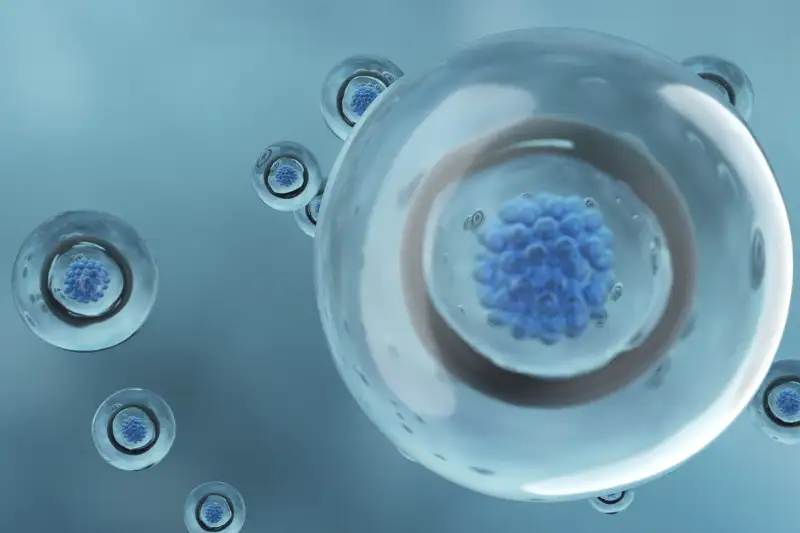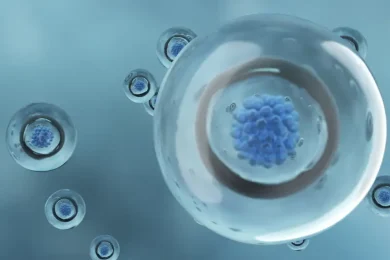What is Preimplantation Genetic Testing (PGT)
Historically, embryos resulting from IVF have been graded based on appearance in an effort to rank those within a group in terms of their likelihood of implanting and leading to a successful pregnancy. However, this method is substantially limited given that embryonic appearance and whether they are chromosomally normal or not (the most important determinant of viability/success) does not correlate very well. In other words, poorly graded embryos can be chromosomally normal and embryos with ideal appearance can be chromosomally abnormal.
Preimplantation genetic testing (PGT) is a technique in which a small sample of cells are removed (biopsied) from the portion of the embryo destined to become the placenta (not the baby), and these cells are then used to perform molecular testing to determine the genetic composition of the embryo as a whole. Depending on the indication for testing, PGT can determine if an embryo is affected by chromosomal abnormalities which may impact implantation, lead to miscarriage, or result in the delivery of a child with a specific genetic disorder.
PGT is optional and the decision of whether, or not, to include it in an IVF treatment plan is complex and individualized. You can expect to have an in-depth discussion with your physician regarding its capabilities and limitations, helping you to decide if it’s right for you. Post-test counseling will also be provided to discuss results, including those which may seem confusing.
How is PGT performed?
Only embryos which have successfully completed development in the lab by culture day five or six and become a blastocyst are eligible for biopsy (removal of a small sample of cells for testing). Blastocysts feature a differentiated outer layer, called the trophectoderm, which becomes the placenta and this is the portion of the embryo which is biopsied. This layer of cells is separate from the inner cell mass, which becomes the baby.
Embryos are cryopreserved (frozen) as soon as they are biopsied as it takes 2-3 weeks to receive test results from the PGT laboratory. Once it becomes known which of the embryos biopsied are chromosomally normal, plans can be made for coordination of an embryo transfer cycle.
It is often asked if embryo biopsy is harmful. Extremely high-quality evidence has shown that embryo biopsy at the blastocyst stage will not impact an embryo’s potential for implantation or live birth.
What is the difference between PGT-A and PGT-M?
PGT-A is the most common type of PGT and stands for preimplantation genetic testing for aneuploidy. All of our cells have 23 pairs of chromosomes for a total of 46. Any or all of these pairs could feature too many or too few and, when this is the case (i.e. abnormal chromosome number), the term aneuploidy is applied. Aneuploidy represents the most common cause of an embryo not implanting or resulting in miscarriage, with or without IVF. A select few examples of aneuploidy have the potential of leading to the delivery of a child with a chromosomal numerical abnormality, and Down syndrome is the most well-known example. PGT-A simply tests embryos to determine whether or not they have the correct number of chromosomes. Ones that do not have no potential for success and would result in a negative pregnancy test or miscarriage if transferred or, in some cases, delivery of a child with a chromosomal abnormality. Similar testing is performed once pregnancy has been achieved by obstetricians to evaluate for these conditions (like Down syndrome). PGT-A allows for such testing before pregnancy even occurs and can also make the overall IVF process much more efficient by avoiding transfer of embryos which have no potential for success and only focusing on the ones that do. Normal embryos per PGT-A have an approximately 70% chance of success, per embryo (abnormal embryos per PGT-A have 0% chance of success). PGT-A also determines the genetic sex of each embryo, information that does not have to be disclosed if not desired.
PGT-M is a more specific test, standing for preimplantation genetic testing for a monogenic condition (or mutation). Some examples, among many, of conditions due to a specific mutation include cystic fibrosis, sickle cell disease, and spinal muscular atrophy. Recognition of the need to test embryos for carriage of a particular mutation typically arises from previously performed parental carrier screening or recognition of a genetic disorder which runs in the family. PGT-A is typically performed concurrently when the plan is for PGT-M.
Consider a set of encyclopedias. PGT-A checks to make sure the set is complete, i.e. no missing or duplicated volumes. It cannot, however, determine if there is a misspelled word on a certain page within a certain volume, but PGT-M can.









